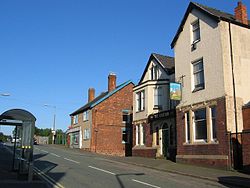Westhouses
| Westhouses | |
| Derbyshire | |
|---|---|
 The Station pub, Westhouses | |
| Location | |
| Grid reference: | SK423579 |
| Location: | 53°7’1"N, 1°22’8"W |
| Data | |
| Post town: | Alfreton |
| Postcode: | DE55 |
| Dialling code: | 01773 |
| Local Government | |
| Council: | Bolsover |
Westhouses is a village in Derbyshire, sitting due north of the town of Alfreton and half a mile west of the nearest village, Blackwell, in the north-east of the county, two and a half miles from the Nottinghsamshire border. Westhouses is named after West House Farm: the village itself was founded in the 1870s by the Midland Railway. The railway which created the village runs though it in a straight line north to south.
Railway
The mainline railway from Nottingham to Chesterfield, now known as the Erewash Valley Line, runs through and here at West House Farm the railway company built facilities for the railway, which resulted in the creation of a new village.
The Midland Railway (later the London, Midland and Scottish Railway) was the main employer and landowner. Many roads such as Allport Terrace, Bolden Terrace and Pettifer Terrace were named after Midland Railway directors, and the school was also built and maintained by the company.
Most of the houses were two-up and two-down, with an outside toilet in the back yard, although the engine drivers' houses were bigger. They did not have mains electricity until the 1950s and were owned by the Midland Railway, later by the British Railways Board until about 1969. There should have been 100 houses by the school but only 75 were built, stopping at 2, Bolden Terrace, making it a semi-detached house by accident.
A station existed from very early in the line's development but was soon closed. The second station became known as Westhouses & Blackwell.
Branch lines ran to New Hucknall colliery and New Hucknall Sidings on the Great Central Railway. A through line ran to Tibshelf, Sutton Colliery, Silverhill, Butcherwood and Pleasley Colliery, finally connecting with the Robin Hood line at Mansfield Woodhouse.
The Midland Railway engine shed included arrival and departure roads, an ash road, six internal roads and the legs road, which once had a shear legged crane positioned over it. This was used for the lifting of locomotives. The shed was intended to be a maintenance centre for the LMS but water supply problems prevented its expansion. Railwaymen's children would often be given a turn driving the locos during the 1930s, and in the diesel era rail enthusiasts would also be allowed to drive locomotives up and down the yard.
Besides working on the railway in the various grades, many local residents found employment at Blackwell Colliery, but there was little other employment and many were out of work in the 1930s depression. A chapel of ease (the tin tabernacle) was built near the School and Recreation ground, and stood until its removal to the Midland Railway - Butterley near Ripley. The organ was played by a lady who reputedly only knew two hymns, one of which was "The day thou gavest" and the other was "To be a pilgrim."
After the 1926 General Strike many villagers boycotted the Trent Bus Company as it had continued running buses during the emergency, and instead they patronised the local village service, which had gone out in sympathy.

In the 1950s and 60's Jinty's 4F's, 8F's and 9F's were most common. In steam days Garratts could be seen pounding up the gradient in front of a long line of coal wagons. When diesels were introduced, classes, 08, 25, 47 and 45 were seen. Into the 1970s British Rail Classes 08, 20, 47 and latterly 56 were the main stay. Classes 25, 45, and 58 also visited the shed.

The
shed closed to locomotives when traffic defects caused a Class 56 to derail and the shed was deemed to be no longer in a usable condition. Operations were moved to Tibshelf sidings until the complete closure of Westhouses as a traincrew depot in January 1987.
The last locally employed railway positions were the travelling shunters based in the flat-topped cabin at the start of Tibshelf Sidings, these positions were however made redundant when Silverhill colliery closed. The village still had a railwayman - Mr.H Turner at Toton, a former Westhouses man from 1960-2002. The building was actually condemned by Walter Warwick, born in 2, Bolden Terrace and who started his career as an engineering apprentice in the Shed, Health and Safety Manager for London Midland Region of British Railways, and the younger brother of Dr.Gordon Warwick, the geomorphologist, born in The Willows, Park Lane.
Outside links
| ("Wikimedia Commons" has material about Westhouses) |
